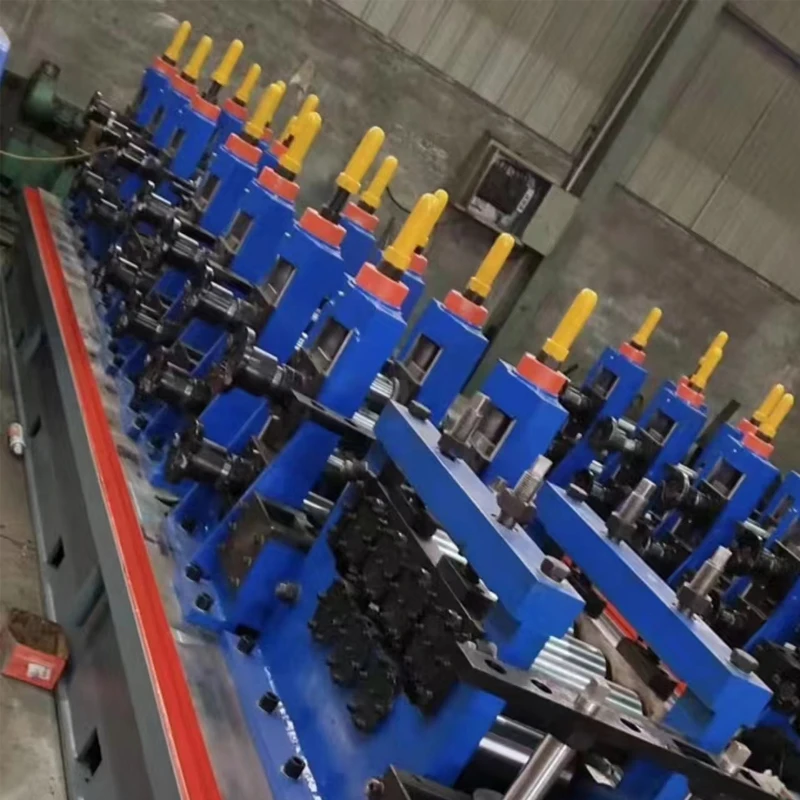Innovative Techniques for Efficient Roll Forming of Tubes and Profiles
Understanding Roll Forming Tube A Versatile Manufacturing Process
Roll forming is a highly efficient manufacturing process widely used to create long strips of metal, which are then shaped into various profiles and forms. One of the most significant applications of roll forming is in the production of tubes. Roll forming tube offers several advantages over traditional tube manufacturing methods, making it an essential technique in various industries, including automotive, construction, and furniture manufacturing.
The Roll Forming Process
The roll forming process involves feeding a metal strip through a series of rolls that gradually shape the metal into the desired profile. The process begins with the selection of raw materials, typically steel, aluminum, or other metals, which are then cut into strips of specific widths. The metal strip is heated if necessary, and then it is fed into a series of rollers that progressively form the material into a tube shape.
The rollers are meticulously designed and arranged to create the desired contour, ensuring that the material is bent uniformly. As the strip moves through the rollers, it maintains a continuous feed, allowing for high production rates. Once the tube is formed, it can be cut to length, welded, or treated to meet specific application requirements.
Advantages of Roll Forming Tube
1. Consistency and Precision Roll forming offers excellent dimensional accuracy and uniformity. The process allows manufacturers to produce tubes with precise measurements, vital for applications requiring tight tolerances.
2. Cost-Effectiveness Due to its high speed and efficiency, roll forming can be more cost-effective than other tube manufacturing methods. This is particularly beneficial for high-volume production runs, where setup costs can be amortized over thousands of units.
3. Material Efficiency Roll forming minimizes waste materials, as the process is designed to utilize as much of the raw strip as possible. This not only lowers material costs but also promotes sustainability by reducing scrap metal.
4. Versatility Roll forming can accommodate a wide variety of materials, including different grades of steel and aluminum alloys. Moreover, manufacturers can create a diverse range of tube profiles, from simple cylindrical shapes to more complex cross-sections.
roll forming tube

5. Strength and Durability The roll forming process imparts structural integrity to the finished product. The continuous nature of the manufacturing means that there are no weak points typically found in welded tubes, resulting in stronger and more reliable products.
Applications of Roll Forming Tube
Roll formed tubes are utilized across multiple industries due to their strength and adaptability.
- Automotive Industry In the automotive sector, roll formed tubes are used in chassis components, bumpers, and structural parts. Their robustness and ability to withstand significant stress make them ideal for safety-critical applications.
- Construction Roll formed tubes serve critical roles in structural applications like scaffolding, framing, and infrastructure builds. They provide reliable support and durability in various construction projects.
- Furniture Manufacturing The furniture industry benefits from roll formed tubes in the creation of frames for chairs, tables, and shelving units. The ability to design aesthetically pleasing and sturdy products is essential in this market.
- Consumer Goods Many household items feature roll formed tubes in their design, from curtain rods to bicycle frames, contributing to the overall functionality and ergonomics of the products.
Conclusion
Roll forming tube is a powerful manufacturing process that has revolutionized how various industries produce metal tubes. Its efficiency, precision, and adaptability make it a crucial technology in today’s manufacturing landscape. As industries continue to seek more sustainable and cost-effective solutions, the demand for roll formed tubes is expected to grow, leading to innovations and advancements in the manufacturing process. Whether for automotive parts, construction materials, or consumer goods, roll forming continues to be a vital component in meeting the needs of modern production.
-
High Frequency Straight Seam Welded Pipe Production Line-BzZhou Xinghua Machinery Equipment Manufacturing Co., LTD.|line pipe steel&welded gas pipeNewsJul.30,2025
-
High Frequency Straight Seam Welded Pipe Production Line-BzZhou Xinghua Machinery Equipment Manufacturing Co., LTD.|High Precision&Automated SolutionsNewsJul.30,2025
-
High Frequency Straight Seam Welded Pipe Production Line - BzZhou Xinghua Machinery Equipment Manufacturing Co., Ltd.NewsJul.30,2025
-
High Frequency Straight Seam Welded Pipe Production Line-BzZhou Xinghua Machinery Equipment Manufacturing Co., LTD.|Precision Welding, High EfficiencyNewsJul.30,2025
-
High Frequency Straight Seam Welded Pipe Production Line|BzZhou Xinghua|Precision Welding&EfficiencyNewsJul.30,2025
-
High Frequency Straight Seam Welded Pipe Production Line - BzZhou Xinghua|Precision Engineering&EfficiencyNewsJul.30,2025


